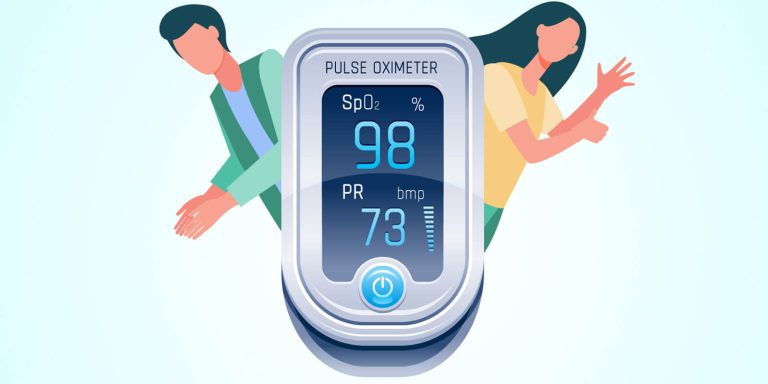

Contact Us Now
Upload Prescription
Not sure which tests to take? Share your prescription with us and our team will call you to book tests for you.

The number of new coronavirus cases across the globe continues to rise by the day, and the healthcare system is overburdened with the consequences of the COVID-19 pandemic. As we try to cope up with this changing world, we are being introduced to more technologies that were once used only in the medical sphere and one such technology is the pulse oximeter device. Today, more people are informed to terms like ‘oxygen saturation’ and ‘pulse oximeter’ in the context of this Novel infection.
A pulse oximeter also referred to as a pulse ox tests an individual’s level of blood oxygen saturation and pulse rate. The requirement for such medical tools is on the verge due to Novel COVID-19 infectious disease. The pulse oximeter attaches painlessly to your fingertip, sending two wavelengths of light through the finger to measure your pulse rate and how much oxygen is in your system. What has been a staple for many doctors over the years, is now a tool of necessity for the layperson in many households. It is an affordable, non-intrusive, and easy to use the device. An oximeter is utilized for identifying hypoxemia or low blood oxygen levels, which is one of the early signs of a COVID-19 infection.
Having normal oxygen levels can be reassuring, although there is no guarantee that someone won’t have a fast decline with their breathing status. Its quite possible that someone has normal oxygen levels, and can quickly progress to very low oxygen levels, sometimes that are life-threatening. Haemoglobin is a protein in the blood that carries oxygen to body cells. This process is vital to ensure the precise functioning of organs and tissues. Any deficiency of oxygen can lead to adverse effects on the different organ systems eventually worsening the immune system.
The oximeter device comprises a monitor that contains the batteries, display, and a light detector. They work by measuring the amount of light reflected or transmitted through the skin at two different wavelengths, and then they use mathematical algorithms to estimate the level of oxygen saturation in the blood.
Pulse oximeters usually need a fingertip (usually the index finger of the right hand) to be inserted into the device and held there for about 10 seconds. The values of oxygen saturation and pulse rate are displayed on the device. If one has painted nails the accuracy of measurement gets affected showing the wrong measure of oxygen saturation. The safe range of the pulse rate is said to be between 60 to 100. While the normal reading for the oxygen level ranges from 95% to 100%. If the SpO2 levels/oxygen saturation levels are falling below 90%, such a case is referred to as hypoxemia, which is abnormally low blood oxygen level, and you will need immediate medical treatment or even inhalational oxygen to keep you out of further health complications.
How to use a pulse oximeter?
The quality of the pulse oximeter, how accurately a person is operating it, which underlying medical condition that person has – all these factors play a significant role in the accuracy of measurements.
These days there are many apps available for mobile and tablets for the oxygen readings, which are erroneous. Thus, even though pulse oximeters do not show perfect results all the time, they are still much more precise compared to online apps. Anyone who has symptoms of COVID-19 or not should use an oximeter to monitor their daily oxygen levels for wellbeing. When purchasing the oximeter consider the most trusted brands to avoid false readings. There are oximeters on various platforms that will work for a month at most before they stop functioning, and may cost as much as the best ones.
Amidst this vulnerable pandemic, it makes sense to have a pulse oximeter at home – just as you might have a thermometer to track fevers. It is a life saviour in cases of hypoxia where the patient does not notice the depletion in oxygen in the blood and it can have severe repercussions.
Meanwhile, abnormal pulses and low oxygen levels are just two possible symptoms of COVID-19 in the list that includes fever, cough, breathing difficulty, chills, muscle pain, headache, sore throat, and loss of smell or test.
Amidst this vulnerable pandemic, it makes sense to have a pulse oximeter at home – just as you might have a thermometer to track fevers. It is a life saviour in cases of hypoxia where the patient does not notice the depletion in oxygen in the blood and it can have severe repercussions.
Meanwhile, abnormal pulses and low oxygen levels are just two possible symptoms of COVID-19 in the list that includes fever, cough, breathing difficulty, chills, muscle pain, headache, sore throat, and loss of smell or test.
Keeping yourself informed about your physical condition during these challenging times can contribute to your welfare and the people around you.
Copyright © Simira Healthcare Private Limited 2024. All Rights Reserved
This will close in 0 seconds
This will close in 0 seconds
Leave a Reply